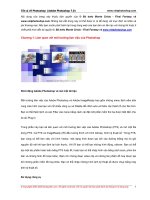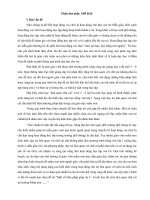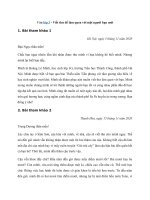Làm quen với linux
Bạn đang xem bản rút gọn của tài liệu. Xem và tải ngay bản đầy đủ của tài liệu tại đây (119.93 KB, 22 trang )
Lab 1:
Working with Linux
1
Login and logout
• Account
– username & password
– Note:
• Linux is case-sensitive
• Administrator: username = root
• Logout: exit, Ctrl+D
2
Linux File System
(C)
WINDOWS
Fonts
(D)
Program Files
System32
….
Data
OS
….
Windows File System
(/)
Music
….
boot
….
home
khoa
etc
root
student1
….
Linux File System
3
Directory/file commands
• List contents of directory :
ls [-a] [-l] [directory_name]
• Print working directory: pwd
• Change working directory :
• Create new directory :
• Remove a directory:
cd directory_name
E.g. cd /home
mkdir directory_name
rm -r directory_name
• Some special symbols :
~ : home directory
.. : parent directory
4
Directory/file commands
• Display file content :
cat filename or more filename
head filename or tail filename
• Copy file(s) or directory:
cp [-r] source_file destination_file
• Remove file or directory
rm –r file_name
• Move (rename) file(s)/directory
mv old_path new_path
5
File system and
permissions
• Each user may owns one or more directories/files
• Each user has different access rights in different
directories/files
users can share their data together
users also can protect their private data
6
File system and
permissions
• Access right on directory/file
– read (r)
– write (w)
– execute (x)
• Each directory/file has 9 access-right bits, divide into 3 groups as
follow :
– owner
– group (e.g. people the same project team)
– others (people in public domain)
7
File system and
permissions
8
Changing access rights
(1)
• Symbolic
chmod who op mode [-R] file(s)
• Who:
u : owner
• Mode:
• Op
g : group
o : others
a : all
r : read
w : write
x : execute
+ : grant more rights
- : revoke rights
= : reset rights
9
Changing access rights
(2)
• Example
$ touch temp
$ ls –l temp
-rw-r--r-- 1 user1 staff 0 Jun 11 11:44 temp
$ chmod o-r temp
$ ls -l temp
-rw-r----- 1 user1 staff 0 Jun 11 11:44 temp
$ chmod u+x, o+r temp
$ ls -l temp
-rwxr--r-- 1 user1 staff 0 Jun 11 11:44 temp
10
Changing access rights
(3)
• Numeric: chmod xyz [-R] file(s)
read = 4
write = 2 execute = 1
Octal value
Access right
7
rwx
6
rw-
5
r-x
4
r--
3
-wx
2
-w-
1
--x
0
--11
Changing access rights
(4)
• Example: some common access rights of
directory/file(s)
Octal value
Access right
600
rw-------
644
rw-r--r--
700
rwx------
751
rwxr-x--x
775
rwxrwxr-x
777
rwxrwxrwx
12
Changing access rights
(5)
• Example
$ touch abc
$ ls –l abc
-rw-r--r-- 1 user1 staff 0 Jun 11 11:44 abc
$ chmod 555 abc
$ ls -l abc
-r-xr-xr-x 1 user1 staff 0 Jun 11 11:44 abc
$ chmod 775 abc
$ ls -l abc
-rwxrwxr-x 1 user1 staff 0 Jun 11 11:44 abc
13
Advanced utilities (1)
• Who is who?
who [option]
• Print current host name
hostname
• Where do they come from?
which [filename]
• How much disk usage?
df [option]
• Clear screen
clear
OR
Ctrl + L
14
Advanced utilities (2)
• Find a specified file :
find path –name filename
• Find lines in file matching a pattern
grep pattern file_name
• Mount and unmount file system
mount -t filesystem device_file mount_point
umount mount_point
15
vi editor
• Interactive simple editor
• Can not use mouse
• Text editing on a buffer
• Appears on most Unix or Unix-like system
16
vi usage
syntax
meaning
vi filename
open/create file
a or i
change to edit mode
ESC → wq!
save and quit
ESC → q!
not save and quit
17
Cursor movement in vi
Cmd
Meaning
n
move cursor left n character(s)
n
move cursor down n character(s)
n
move cursor up n character(s)
n
move cursor right n character(s)
Enter move cursor to beginning of next line
G
move cursor to the last line
nw
move cursor left n word(s)
nW
move cursor right n word(s)
18
Cmd
Text manipulation
commands
Meaning
nx
delete n character(s) from current cursor
position
nX
delete n character(s) immediately preceding
current cursor position
D, d$ delete all characters from current cursor
position to end of line
d0, d| delete all characters from left collumn of
screen to character preceding current cursor
position on current line
19
Cmd
Text manipulation
commands
Meaning
ndd
delete n line(s) beginning at current line
dG
delete all lines, starting with current line, through
end of file
d1G
delete all lines, starting with current line, through
beginning of file
ndw
delete from cursor position through end of n
following word
ndb
delete from nearest preceding word through
character before current cursor position
J
join the next line at the end of current line
20









